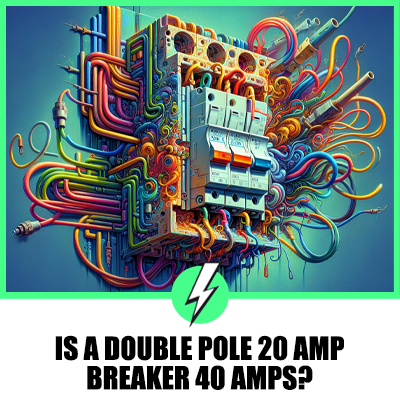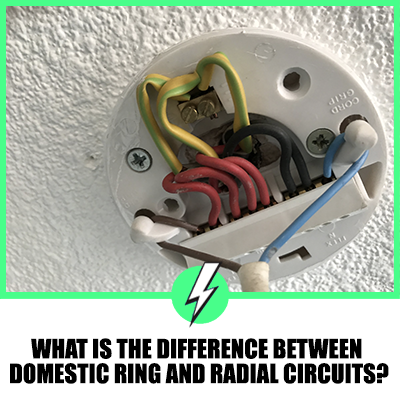Is a Double Pole 20 Amp Breaker 40 Amps?
Ever scratched your head, wondering if a double pole 20 amp breaker actually equates to 40 amps?
You’re not alone in this electrical conundrum. It’s a question that often surfaces among homeowners and DIY enthusiasts alike, signaling a common quest for clarity in the sometimes mystifying world of electrical circuits.
Well, we’ll be going over:
- What exactly is a double pole 20 amp breaker, and how does it function within your electrical system?
- How do electrical circuits work, and what role does a double pole breaker play in this ecosystem?
- Why is it a misconception to think of a double pole 20 amp breaker as providing 40 amps, and what’s the reality?
Let’s dive in

Contents
Explaining a Double Pole 20 Amp Breaker
When you’re diving into the details of your home’s electrical system, understanding the role and functionality of a double pole 20 amp breaker is crucial.
Essentially, this type of breaker is designed to monitor and control two separate circuits simultaneously while being linked to a common mechanism.
The primary confusion arises from the misconception that a double pole breaker doubles the amp capacity. However, it’s vital to grasp that a double pole 20 amp breaker does not, in fact, supply 40 amps overall.
Instead, it provides 20 amps to each of the two circuits it controls. This means that each line can handle up to 20 amps of current independently, yet they are safeguarded by the same breaker switch.
Understanding the amperage and how it’s distributed across circuits can help prevent the common pitfalls of overloading your electrical system.
Knowing the specifics of how a double pole 20 amp breaker functions within your home can ensure that your electrical systems run smoothly and safely.
Understanding Electrical Circuits
When you’re dealing with electrical systems in your home, it’s fundamental to grasp how circuits work. Essentially, your home’s electrical service panel is a central hub where all circuits begin.
Each circuit is protected by a circuit breaker, designed to prevent electrical overloading and potential hazards.
A double pole 20 amp breaker is special in this context. It’s designed to handle appliances or systems that require 240 volts, such as air conditioners or large kitchen appliances.
Think of it as a gatekeeper for two 120-volt circuits, ensuring they operate smoothly without overloading.
Remember, the 20 amps do not stack up to make 40 amps. Instead, each circuit gets a dedicated 20 amps of protection.
This design ensures that high-demand appliances can run safely and efficiently, safeguarding your home from electrical issues.
Debunking the Misconception
When you hear “double pole 20 amp breaker”, it’s easy to think you’re dealing with a 40 amp capacity. But that’s not quite right.
The reality is a bit different and understanding this nuance is key to safely managing your home’s electrical demands.
Firstly, a double pole breaker is essentially two single pole breakers joined together. They’re used for 240-volt circuits, providing each side of the circuit with 20 amps of protection.
It’s crucial to remember that the amp rating doesn’t double because the two poles are connected; instead, each pole can handle up to 20 amps.
This setup ensures that appliances requiring a 240-volt supply receive the necessary power safely, without tipping over the safety limits of your electrical system.
Misinterpreting this can lead to incorrect assumptions about your system’s capacity and might even push it beyond its safe operational limits.
Difference Between Amperage and Breaker Capacity
Understanding the distinction between amperage and breaker capacity is essential when navigating electrical systems in your home.
Amperage refers to the electrical current flowing through the circuit, measured in amps, while breaker capacity indicates the maximum current a breaker can handle before tripping to prevent overload.
For example, a double pole 20 amp breaker is designed to carry up to 20 amps on each pole but is not equivalent to a 40 amp capacity for a single circuit. It’s vital for safely managing electrical loads without exceeding the system’s capability.
This nuance helps in planning appliance and device usage, ensuring that the demand does not surpass what the breaker can safely manage.
Recognising this difference prevents potential electrical hazards, promoting a safer environment in your home.
Clarifying the Role of the Double Pole 20 Amp Breaker
Understanding the specifics of a double pole 20 amp breaker is key when dealing with your home’s electrical system.
This type of breaker is designed to monitor and control the current flow across two separate circuits simultaneously, each carrying up to 20 amps.
It’s essential to note that it doesn’t double the available amperage to 40 amps for a single circuit, but rather maintains a maximum of 20 amps per circuit.
The functionality of the double pole breaker allows it to trip if either circuit experiences an overload, ensuring a higher level of safety.
This is particularly useful for appliances that require a connection to both phases of your home’s electrical system, such as dryers or ovens, providing a balanced load across the two circuits.
Remember, integrating a double pole 20 amp breaker into your home’s electrical setup should always align with your overall electrical capacity and needs.
It’s not about increasing capacity arbitrarily but ensuring safe, efficient, and balanced distribution of electrical current across your appliances and electrical devices.
Conclusion
Understanding the role and capacity of a double pole 20 amp breaker is crucial for your home’s electrical safety and efficiency. It’s not about doubling amperage but ensuring a balanced and safe distribution of power across two circuits.
Remember, it’s designed to keep your appliances running smoothly without the risk of overload by maintaining a strict 20 amps limit per circuit.
Always consider your home’s overall electrical needs when integrating such breakers to enhance safety and functionality.
With this knowledge, you’re better equipped to make informed decisions about your electrical system’s setup and maintenance.





